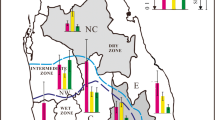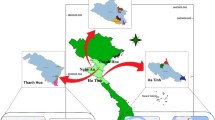Abstract
Consumption of contaminated food is a major route of exposure to toxic contaminants for humans. To protect against potential negative health effects from rice consumption, As and Cd concentrations in rice sold in Bangkok were determined, and non-carcinogenic and carcinogenic risk assessments were conducted. Four types of rice (n = 97), namely, white jasmine, white, glutinous, and brown jasmine, were collected. Samples were acid-digested and analyzed for total concentrations of As and Cd by ICP-MS. The average concentrations of As and Cd were 0.205 ± 0.008 and 0.019 ± 0.001 mg kg−1, respectively. Approximately 22.8, 62.5, and 57.1% of white, white jasmine, and brown jasmine rice, respectively, contained As concentrations exceeding the Codex inorganic As standards for polished and unpolished rice. Brown jasmine rice contained significantly higher As concentrations than the other types of rice. However, Cd concentrations in all rice samples were significantly lower than the Codex standard of 0.4 mg kg−1. Children are exposed to the highest amounts of both elements. Concerning As exposure through the consumption of different types of rice in the same age group, the consumption of brown jasmine rice caused approximately 1.7 to 2.3 times higher As exposure rates compared to the consumption of other types of rice. Non-carcinogenic risks (hazard quotient (HQ)) of As exposure from all types of rice were higher than the threshold limit of 1. HQ in children ranging from 2.1 to 4.9 was significantly higher than HQ in the other age groups. The cancer risks from As exposure were negligible in all groups.


Similar content being viewed by others
References
Ahmed, M. K., Shaheen, N., Islam, M. S., Habibullah-Al-Mamun, M., Islam, S., & Banu, C. P. (2015). Trace elements in two staple cereals (rice and wheat) and associated health risk implications in Bangladesh. Environmental Monitoring and Assessment, 187, 326.
Arunakamara, K. K. I. U., Walpola, B. C., & Yoon, M. H. (2013). Current status of heavy metal contamination in Asia’s rice lands. Reviews in Environmental Science and Bio/Technology, 12, 355–377.
Codex Alimentarius Commission. (2014). Joint FAO/WHO food standards programme (Codex Alimentarius Commission) 37th session Geneva, Switzerland, 14–18 July 2014 and report of the eighth session of the Codex committee on contaminants in foods, The Hague, The Netherlands, 31 March-4 April 2014. http://www.codexalimentarius.org/download/report/906/REP14_CFe.pdf Accessed 9 February 2017.
Codex Alimentarius Commission. (2016). Joint FAO/WHO food standards programme (Codex Alimentarius Commission) 39th session Rome, Italy, 27 June-1 July 2016 and report of the 10th session of the Codex committee on contaminants in foods, Rotterdam, The Netherlands, 4–8 April 2016. http://www.fao.org/fao-who-codexalimentarius/sh-proxy/zh/?lnk=1&url=https%253A%252F%252Fworkspace.fao.org%252Fsites%252Fcodex%252FMeetings%252FCX-735-10%252FReport%252FREP16_CFe.pdf Accessed 26 September 2017.
Commonwealth of Australia. (2012). Environmental health risk assessment—guidelines for assessing human health risks from environmental hazards. http://www.eh.org.au/documents/item/916. Accessed 27 March 2017.
Fu, Q. L., Li, L., Achal, V., Jiao, A. Y., & Liu, Y. (2015). Concentrations of heavy metals and arsenic in market rice grain and their potential health risks to the population of Fuzhou, China. Human and Ecological Risk Assessment, 21, 117–128.
Islam, S., Rahman, M. M., Islam, M. R., & Naidu, R. (2016). Arsenic accumulation in rice: consequence of rice genotypes and management practices to reduce human health risk. Environmental International, 96, 139–155.
Israel, G.D. (1992). Fact sheet PEOD-6: determining sample size. http://www.sut.ac.th/im/data/read6.pdf. Accessed 6 June 2016.
Jallad, K. N. (2015). Heavy metal exposure from ingesting rice and its related potential hazardous health risks to human. Environmental Science and Pollution Research, 22, 15449–15458.
Laoharojanaphand, S., Busamongkol, A., Permnamtip, V., Judprasong, K., & Chatt, A. (2012). A pilot study to measure levels of selected elements in Thai foods by instrumental neutron activation analysis. Journal of Radioanalytical and Nuclear Chemistry, 294, 323–327.
Meharg, A.A., Zhao, F.J. (2011). Arsenic & rice. Springer Science+Business Media.
Meharg, A. A., Lombi, E., Williams, P. N., Scheckel, K. G., Feldmann, J., Raab, A., Zhu, Y., & Islam, R. (2008). Speciation and localization of arsenic in white and brown rice grains. Environmental Science and Technology, 42, 1051–1057.
Meharg, A. A., Williams, P. N., Adomako, E., Lawgali, Y. Y., Deacon, C., Villada, A., Cambell, R. C. J., Sun, G., Zhu, Y. G., Feldmann, J., Raab, A., Zhao, F. J., Islam, R., Hossain, S., & Yanai, J. (2009). Geographical variation in total and inorganic arsenic content of polished (white) rice. Environmental Science and Technology, 43, 1612–1617.
Meharg, A. A., Norton, G., Deacon, C., Williams, P., Adomako, E. E., Price, A., Zhu, Y., Li, G., Zhao, F. J., McGrath, S., Villada, A., Sommella, A., De Silva, P. M. C. S., Brammer, H., Dasgupta, T., & Islam, M. R. (2013). Variation in rice cadmium related to human exposure. Environmental Science and Technology, 47, 5613–5618.
Ministry of Public Health. (2003). Notification of the Ministry of Public Health (No.273) B.E.2546 (2003): standard of contaminants in food. https://food.fda.moph.go.th/law/data/announ_moph/V.English/No.%20273%20Standard%20of%20contaminants%20in%20food%20(No.%202).pdf. Accessed 6 June 2016.
Moriyama, T., Shindoh, K., Taguchi, Y., Wanatabe, H., Yasui, A., & Joh, T. (2003). Changes in the cadmium content of rice during the milling process. Shokuhin Eiseigaku Zasshi, 44(3), 145–149.
National Bureau of Agricultural Commodity and Food Standards, Ministry of Agriculture and Cooperatives. (2006). Food consumption data of Thailand [in Thai]. https://www.acfs.go.th/document/download_document/food_consumption_data.pdf. Accessed 6 June 2016.
Nookabkaew, S., Rangkadilok, N., Akib, C. A., Tuntiwigit, N., Saehun, J., & Satayavivar, J. (2013a). Evaluation of trace elements in selected foods and dietary intake by young children in Thailand. Food Additives & Contaminants: Part B, 6(1), 55–67.
Nookabkaew, S., Rangkadilok, N., Mahidol, C., Promsuk, G., & Satayavivar, J. (2013b). Determination of arsenic species in rice from Thailand and other Asian countries using simple extraction and HPLC-ICP-MS analysis. Journal of Agricultural and Food Chemistry, 61, 6991–6998.
OECD/Food and Agriculture Organization of the United Nations. (2015). OECD-FAO agricultural outlook 2015. Paris: OECD Publishing. https://doi.org/10.1787/agr_outlook-2015-en. Accessed 13 January 2017.
Phan, K., Sthiannopkao, S., Heng, S., Phan, S., Huoy, L., Wong, M. H., & Kim, K. W. (2013). Arsenic contamination in the food chain and its risk assessment of populations residing in the Mekong River basin of Cambodia. Journal of Hazardous Materials, 262, 1064–1071.
Robson, M. G., & Toscano, W. A. (2007). Risk assessment for environmental health. San Franscisco: Jossey-Bass 628 pp.
Rohman, A., Helmiyati, S., Hapsari, M., & Setyaningrum, D. L. (2014). Rice in health and nutrition. International Food Research Journal, 21(1), 13–24.
da Silva, A. L. O., Barrocas, P. R. G., Jacob, S. C., & Moreira, J. C. (2005). Dietary intake and health effects of selected toxic elements. Brazil Journal of Plant Physiology, 17(1), 79–93.
Tongesayi, T., & Tongesayi, S. (2014). The new inconvenient truth: global contamination of food by chemical pollutants, particularly heavy metals and metalloids. ACS Symposium Series, 1159, 15–40.
Tsai, C. F., Shih, D. Y. C., & Shyu, Y. T. (2010). Survey and risk assessment of trace elements in foods from Taiwan containing red mould rice (Monascus) by ICP-MS. Food Additives & Contaminants: Part B, 3(4), 228–235.
U.S. Environmental Protection Agency (U.S. EPA). (1989). Risk assessment guidance for superfund volume I human health evaluation manual (part A) interim final. (EPA/540/1–89/002 December 1989).https://www.epa.gov/sites/production/files/2015-09/documents/rags_a.pdf. Accessed 2 March 2017.
U.S. Environmental Protection Agency (U.S. EPA). (2016a). Arsenic, inorganic (CASRN 7440–38-2). https://cfpub.epa.gov/ncea/iris2/chemicalLanding.cfm?substance_nmbr=278. Accessed 18 May 2016.
U.S. Environmental Protection Agency (U.S. EPA). (2016b). Cadmium (CASRN 7440–43-9). https://cfpub.epa.gov/ncea/iris2/chemicalLanding.cfm?substance_nmbr=141. Accessed 18 May 2016.
Watanabe, T., Shimbo, S., Moon, C. S., Zhang, Z. W., & Ikeda, M. (1996). Cadmium contents in rice samples from various areas in the world. Science of the Total Environment, 184, 191–196.
World Health Organization. (2012). Life expectancy. https://www.who.int/gho/countries/tha/country_profiles/en/. Accessed 15 June 2016.
Zarcinas, B. A., Pongsakul, P., McLaughlin, M. J., & Cozens, G. (2004). Heavy metals in soils and crops in Southeast Asia. 2. Thailand. Environmental Geochemistry and Health, 26, 359–371.
Zavala, Y. J., & Duxbury, J. M. (2008). Arsenic in rice: I. Estimating normal levels of total arsenic in rice grain. Environmental Science and Pollution Research, 42, 3856–3860.
Zhang, Z. W., Shimbo, S., Watanabe, T., Srianujata, S., Banjong, O., Chitchumroonchokchai, C., Nakatsuka, H., Matsuda-Inoguchi, N., Higashikawa, K., & Ikeda, M. (1999). Non-occupational lead and cadmium exposure of adult women in Bangkok, Thailand. Science of the Total Environment, 226, 65–74.
Zwicker, R., Promsawas, A., Zwicker, B. M., & Laoharojaanaphand, S. (2010). Cadmium content of commercial and contaminated rice, Oryza sativa, in Thailand and potential health implications. Bulletin of the Environmental Contamination and Toxicology, 84, 285–288.
Funding
This research was financially supported by the 90th Anniversary of Chulalongkorn University Fund (Ratchadaphiseksomphot Endowment Fund) and the International Environmental Research Institute (IERI), Gwangju Institute of Science and Technology, Republic of Korea.
Author information
Authors and Affiliations
Corresponding author
Rights and permissions
About this article
Cite this article
Hensawang, S., Chanpiwat, P. Health impact assessment of arsenic and cadmium intake via rice consumption in Bangkok, Thailand. Environ Monit Assess 189, 599 (2017). https://doi.org/10.1007/s10661-017-6321-8
Received:
Accepted:
Published:
DOI: https://doi.org/10.1007/s10661-017-6321-8




